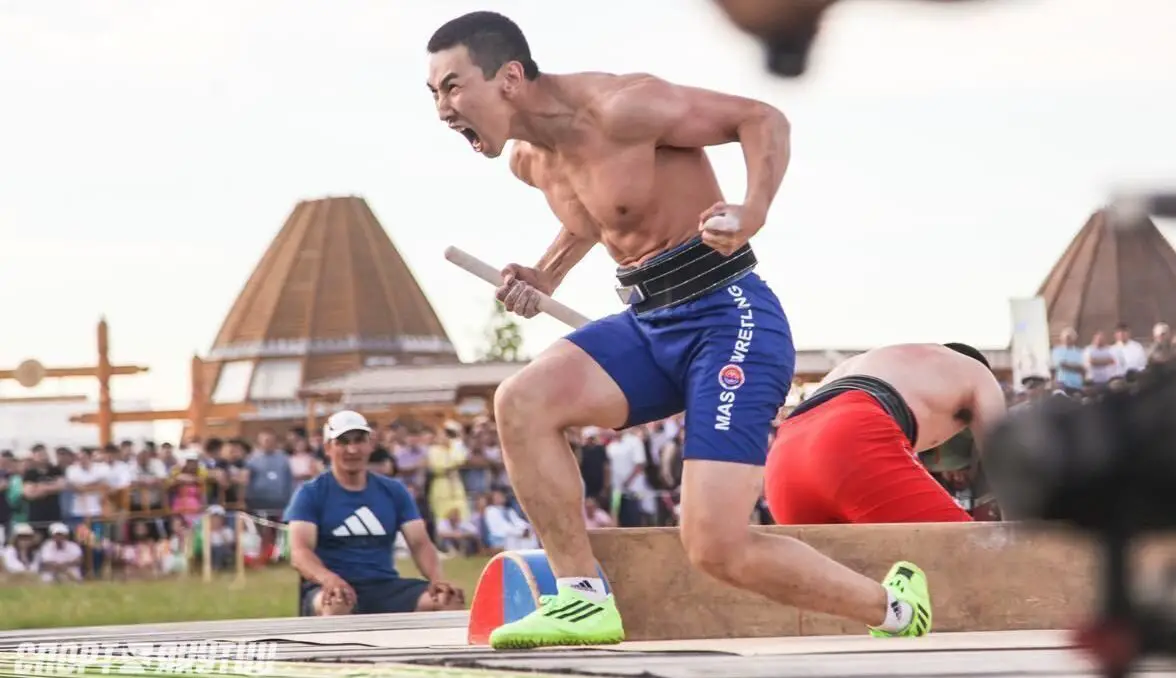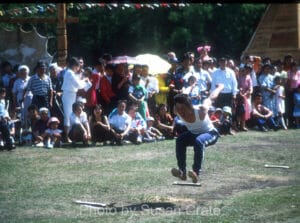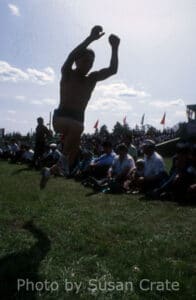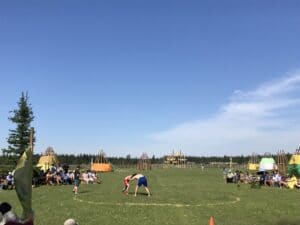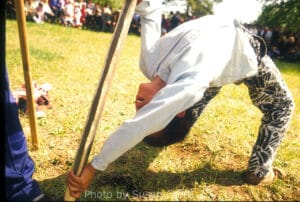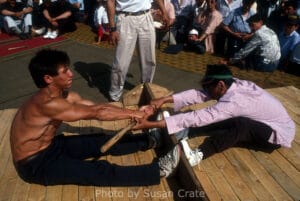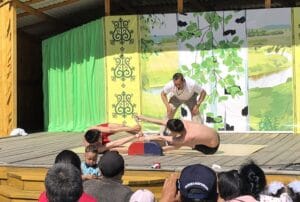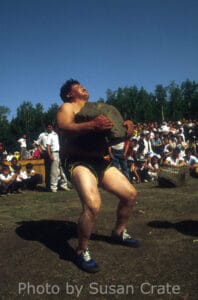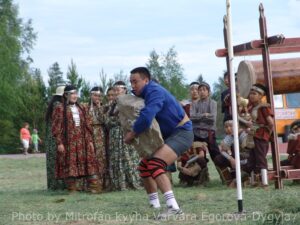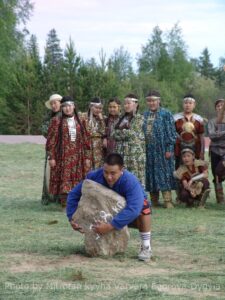The original Sakha is given for some terms in parentheses.
Photographs provided by Mitrofan kyyha Varvara Egorova-Dygyia, Susan Crate, and Kathryn Yegorov-Crate.
The Games of Dygyn or the Dygyn oonn’uulara (Дыгын оонньуулара), as they are known locally, is a multisport competition held in the Republic of Sakha, located in Siberia. It is comprised of seven sporting disciplines all which are native to the indigenous Sakha People.
In Sakha, the term Sakha torut oonn’uulara (Саха төрүт оонньуулара) roughly translates to “the native games of the Sakha people.” The multiple meanings of the word torut (төрүт) are interesting to point out: “born with a people,” “historically established,” “ancient,” “national,” and “native.” These are all applicable to these games, which are linked to the Sakha’s understanding of themselves as a people.
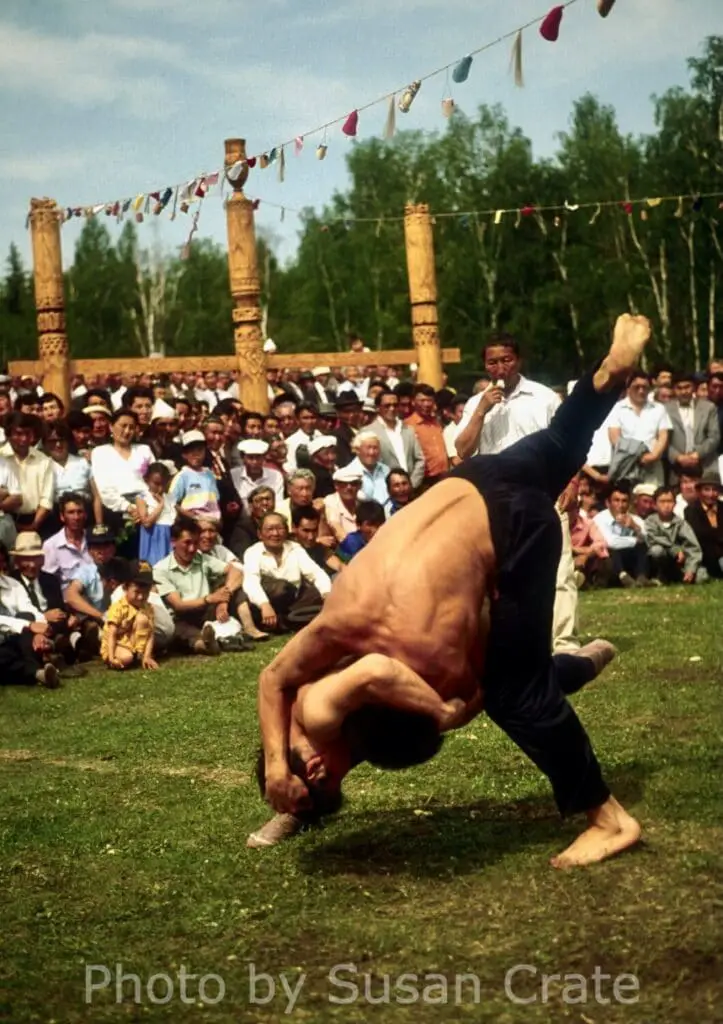
For centuries, tournaments have been a well-established part of the yhyakh festival and reflected the traditional clan-based social character of Sakha society. In the past, young men participated in the games to demonstrate their capabilities as warriors and display their virility for prospective spouses. A toion (тойон), a lord or a head of a clan, could also assess the strength of the men in his regiments. The origins of these sports are also closely tied to horse and cattle breeding, hunting, and fishing, which have been the primary traditional Sakha means of subsistence in their Siberian homeland.
The tournament in its modern form has been held in the city of Yakutsk since 1990, and since 1995 has been known as the Dygyn oonn’uulara, named in honor of Dygyn Darkhan (Дыгын Дархан), the Sakha chief often credited with uniting the Sakha into a single nation and who fought against the Russian conquest of Siberia in the 1600s.
Although the earliest initiation of inter-clan Sakha sporting competitions remains an enigma, it is commonly believed that Dygyn Darkhan initiated a competition similar to the one today, which called for the strongest, smartest, and most worthy booturs (боотур) or warriors, to gather from across the Sakha lands. Today, the Dygyn Games attract the strongest, most dexterous, and fastest sportsmen from across the Sakha Republic. They take on seven strongman challenges to compete for the honor of being named the winner of the Dygyn Games. The winners are revered as Sakha national heroes and thought of as examples for Sakha youth to emulate.
Above: Tutum ergiir (тутум эргиир), a description of the sport can be found below.
Booturs and Ancient Sakha Warfare
A bootur is a Sakha warrior-hero similar to the Russian bogatyr. Traditionally, children who wished to become booturs began their specialized training at a young age. They were taught swordsmanship, archery, wrestling, hand-to-hand combat, and horse-riding. What today are regarded as ancestral sports were once used as extremely rigorous tests that each aspiring bootur had to successfully pass.
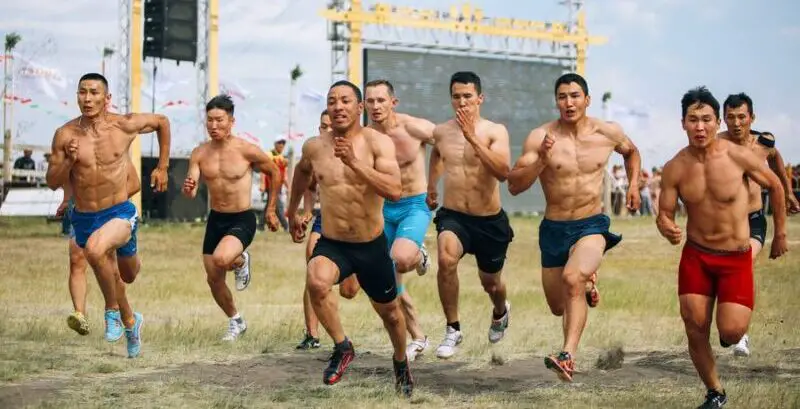
The most intensive development of these tests of strength, agility, and intelligence occurred in the 15th and 16th centuries. This period preceding the annexation of the central Sakha region by imperial Russia is called the kyrgys uiete (кыргыс үйэтэ), a period of inter-clan conflict. Translated literally, kyrgys uiete means “century of destruction”: kyrgys comes from the Sakha verb kyrt (кырт), meaning “to cut” or “to destroy/exterminate” and uiete (үйэтэ) is made up of uie, meaning “century”, and the possessive affix –te.
Countless stories and legends have maintained information about the inter-clan conflicts, heroic battles, bloody wars, and their participants. As might be expected, this period saw military training rise to its greatest importance in Sakha society.
In the kyrgys uiete, conflict became an everyday part of life. However, it also eventually led to the unification of the clans through shared interests and common enemies. These mergers were reinforced by organizing symbolic ceremonies and celebrations. The most important of these was yhyakh with its religious rituals and sports competitions.
Above: Women do not participate in the Dygyn Games but they are also masters of mas tardyhyy or stick-wrestling.
One of the core elements of yhyakh at this time was Sakha wrestling or khapsaghai, which was regarded as the ultimate demonstration of a warrior’s preparedness to protect his clan and his readiness for war. Each warrior’s wrestling ranking also had an impact on his social position within the clan. Poetic and extremely emotive accounts of khapsaghai winners are found in surviving folklore, many of which are still performed today.
The unique culture of Sakha combat sports, khapsaghai in particular, reflects a range of values and traditions formed over centuries of living in extreme environmental and sociopolitical climates. Today, these lessons in warfare take on a more symbolic meaning, representing the struggle between winter and summer, between the old and the new, and hold important significance in the historic heritage of the Sakha people.
The Legendary Bootur, Dygyn Darkhan
Dygyn Darkhan, the Sakha chief believed to have inaugurated the inter-clan multisport competition in its present form, was the head of the Khangalass tribe of Sakha. He was a skilled warrior whose many feats are canonized in numerous Sakha legends. The particulars of Dygyn Darkhan’s life remain murky as the Sakha only adopted writing after Russian conquest. Traditionally, they have relied on oral history to transmit their stories and traditions.
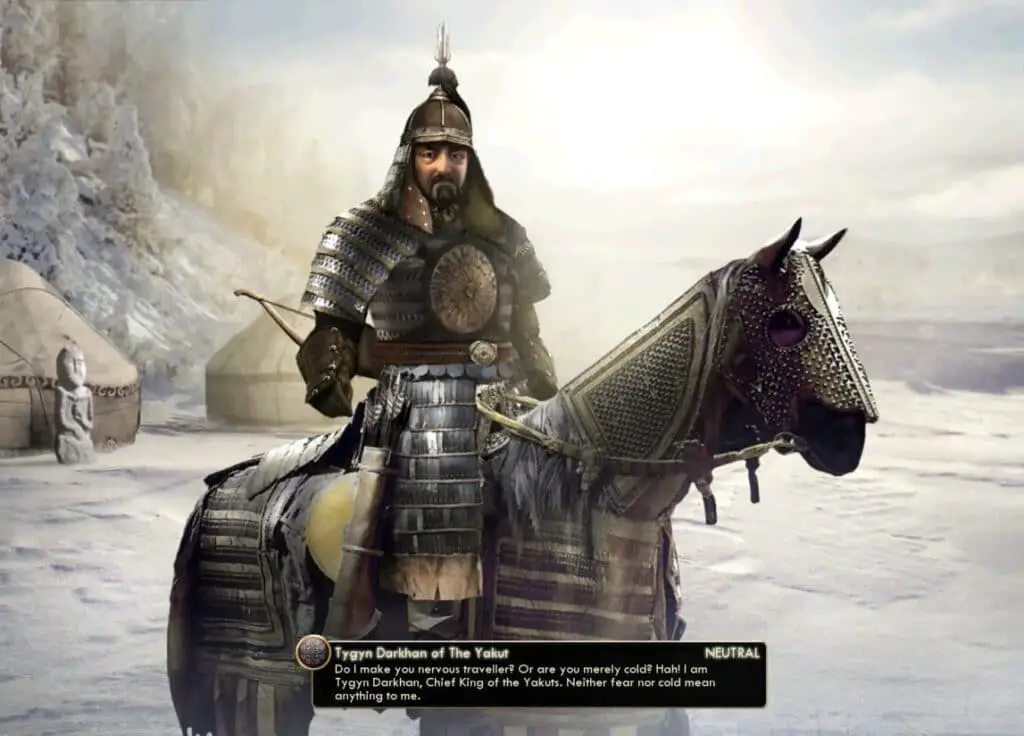
Dygyn Darkhan was born sometime in the later 1500s and lived until 1631. There are a great many legends about him. He is believed to have been a direct descendant of Ellei Bootur, the progenitor of the modern Sakha people. He is also believed to have held estates in the fertile areas of the expansive Tuimaada Valley on the left bank of the Lena River. A rich noble, his herds of horses and cattle are said to have been vast and his troops, herdsmen, and servants numerous. Particularly in versions of the legend originating in the agriculturally rich Vilyui District, Dygyn is portrayed as an otherworldly hero.
To this day, there remains no consensus on his role as a historical figure, but some historians regard him as the most likely unifier of the scattered and fragmented Sakha feudal tribes. According to this line of thinking, Dygyn sought to unite the Sakha in order to create a nation-state base, similar to the 9th century unification of Russia under the Kyivan princes. Other historians, however, stress that his harsh policies led not to the merging of clans, but rather to further alienation and deeper decentralization among the tribes. The details of Dygyn’s death also remain uncertain with some claiming he died a prisoner of the Russians, and others arguing that he died of old age.
Vasily Yakovlev-Dalan’s seminal Sakha-language novel Dygyn Darkhan (1994), which is based on ancient legends and accounts, ignited present-day interest in Dygyn. Dalan depicts Dygyn as fundamentally enigmatic – noble of spirit but cruel of temper. It was not until Dalan’s novel achieved widespread acclaim that the images of Dygyn and other toions sullied during the Soviet era were rehabilitated. The introduction to his book can be seen in the original and in Russian translation here.
Regardless of lack of consensus, Dygyn is a generally popular historical figure in the Sakha Republic today, widely regarded as a sort of founding father whose military capabilities and energetic and vigorous spirit are widely revered. Dygyn’s successors carry this same mythical torch. His descendants, for instance, fought against the devastating yasak or fur tax system, which is now remembered infamously in Sakha history and which led to the impoverishment of many Sakha, social strife, and overhunting. The line of Dygyn retained influence in the political life of Yakutia for many years to come and his successors made their marks on the history of Yakutia, influencing its modern statehood. Today, ancestral connections to the line are still a badge of honor in the Sakha republic.
Despite the very real shroud of ambiguity, it is this legacy of valor and bravery, inquisitiveness and righteousness, and, now, as a source of national pride, that informs popular descriptions of Dygyn Darkhan, and subsequently, of the Games of Dygyn today.
Above: Watch the final for the Federation Cup Tournament for khapsaghai. A description of the sport can be found below.
The Games of Dygyn Competition
The Dygyn Games are supported by the republic’s Vasily Manchaary Center of National Sports and the State Budgetary Institution of the Sakha Republic, whose objectives are to promote healthy lifestyles and to popularize national sports and games. The two-day competition usually takes place in June before yhyakh and is hosted by the Yhyakh Tuymaada, the region’s largest yhyakh festival, which can draw up to 200,000 participants and spectators.
Male amateur and professional athletes alike, aged eighteen to forty, are allowed to compete. However, months prior to the tournament, special selections are held during which each participant must pass a number of special requirements to demonstrate their readiness and competence for the competition. The requirements are rigorous an only thirty to forty of the best athletes from across the Sakha Republic are able to compete in the qualifying competitions held in April and May. Only the top twelve or thirteen contestants qualify for the final competition.
Day One of the Competition
On the first day of the games, there are three contests – us togul us, tutum ergiir, and khapsaghai.
The us togul us (үс төгүл үс) literally means “three-on-three” jumps. Participants must perform three different kinds of jumps, called atakh oonn’uuta (атах оонньуута) in Sakha, in succession. The first is called kylyy (кылыы) which uses one leg; the second, ystanga (ыстаҥа) alternates feet; and the third, kyobakh (куобах), is a “bunny-like” hop using both legs. Contestants have to begin each jump with a running start and are not allowed to stop until they have completed the jumps. The best result of the three tries informs their overall score for the us togul us category.
Tutum ergiir (тутум эргиир) is often rendered into English as “Sakha turntable” and is one of the more unique ancestral sports. Tutum ergiir is performed as follows: Contestants grab one end of stick with both hands and place the other end in a hollowed-out groove on the ground. Without readjusting their initial grip on the stick, contestants must bend and twist to perform a complete 360º turn back to their original position. Each contestant has two minutes to complete as many turns as they are able without lifting the stick out of the hollow. The competitor with the most turns wins.
The last event of the first day is Sakha wrestling called khapsaghai (xапсаҕай), which literally means “a competition in agility.” Khapsaghai is an extremely popular kind of martial art in the Sakha Republic and originated as one of the basic components of the art of ancient Sakha warfare. This specific version of wrestling follows unique khapsaghai rules and does not adhere to standard weight divisions. Contestants are paired and eliminated after their second defeat until one winner remains.
If thirteen participants qualified for the Games, the athlete with the worst results from the first day is eliminated.
Above: This video shows several of the sports of the Dygyn competition as well as medals and trophies awarded.
Day Two of the Competition
Four contests are held on the second and final day of the competition – oghunan ytyy, mas tardyhyy, suuruu, and taahy kotoghuu.
Oghunan ytyy (oҕунан ытыы), or archery, literally translates to “shooting with an arrow.” The target is placed 35 meters (nearly 40 yards) away and has a number of pins, with point values from 1-10, which must be hit with the arrow and knocked out. Contestants are allowed two test shots in addition to a set of five rounds. The participant with the highest number of points from their five shots wins.
Mas tardyhyy (мас тардыһыы), or stick-wrestling, is another unique Sakha sport. Contestants compete in pairs. They sit on the ground, facing each other with their legs in front of them and feet touching a board. Each opponent places one hand on the center and the outer end of stick placed between them. Whoever pulls the other opponent over the board, lifting him from his seated position wins. There are two rounds, sometimes best of three.
Suuruu (сүүрүү) is a 400-meter race. All twelve participants run at once. It is sometimes called kyyhyy ekkiretii (кыыһы эккирэтии), which means “running after a girl,” although this name is now considered outdated by most.
The final contest is the taahy kotoghuu (тааһы көтөҕүү) or boulder carrying. The boulder, called a symara taas (сымара таас), weighs anywhere from 110 kg (242 lb) to 117 kg (257 lb). The contestant who travels the greatest distance while carrying the stone wins. The boulder can be held in any fashion except hoisted upon the shoulders. Each participant is given two minutes to prepare themselves and lift the boulder before they begin to walk.
The scores from each completion are totaled and the contestant with the highest score wins the Dygyn Games and the grand prize, which in the past has been a new car or motorcycle. Previous winners are allowed to participate in the games again, provided that they meet the age and physical fitness requirements. For the Dygyn Games, it is common for the same contestant to have multiple victories and often in a row. The record for this is held by Uibaan Belolyubskai, a seven-time winner and four-time runner up from the Uus-Aldan District in the central part of the republic.
Dygyn Games Today
Due to Covid-19, the 2020 Dygyn Games were postponed and ultimately held December 5–6 in the Triumph Sports Training Center in Yakutsk, without spectators. The tournament was broadcast live by the Sakha National Broadcasting Company. The winner of the 2020 tournament was Leonid Filippov, a member the Russian National Guard from the Amginsky District in the south. Filippov took home a highly esteemed title and a grand prize cash award of one million rubles.
These folk games transmit values and knowledge to younger generations and facilitate physical and mental development, encouraging creativity and bodily health. With this in mind, it is becoming increasingly common to hold miniature Dygyn Games for school-age children to participate in. Young boys compete with their classmates in khapsaghai, stick-wrestling, arm-wrestling, us togul us, suuruu, and other team games. Teachers and parents act as referees and judges, which also helps create connections between parents and the school. According to the children who partake, these mini Dygyn Games allow them to develop a sense of responsibility and teamwork, and to test their willpower and build character. But most importantly, they have fun and learn about their native culture.
The national sports of the Sakha people have deep roots and have been widespread since at least the 16th century, reflecting the Sakha ethnic identity and the developmental history of its collective peoples. Dygyn oonn’uulara and Sakha torut oonn’uulara allow for the Sakha people to pass national traditions and customs from one generation to the next. The Dygyn Games is also a highly social event as people gather to watch it broadcast or to attend in person. The transmission of culture through play and competition ensures that Sakha children and adults alike perceive their culture as living and real.
Above: The livestreams from day one and two of the 2020 Dygyn Games are available online via the Sakha National Broadcasting Company.

